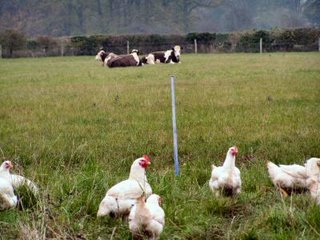Free (Market) Byrd
 "Free-range?" "Cage-free?" My profession's soul goeth to the Devil (some say marketers are already born of it, but I dunno). Conscious consumerism? I'm an unwitting cog in the wheel trying to make a difference in the world with my actions- but there are world populations, governments, free markets, subsidized markets and economic and cultural ways of life that stand in my way. "Free range" was among the topics of discussion on a recent Fresh Air with Terry Gross interviewing guest author of "The Omnivores Dilemma." Truly "free range" chickens actually live outside, (yes, tell me something I wouldn't already know in concept please!) eat the grubs out of cow patties and then spread the corresponding nitrogen back into the field through their waste. But with big business in the way, the process is corrupted and even those producers of the "organic, free range" products are financially strong-armed into being part of the system. It's odd the way commerce starts from the root of something natural (like eating to survive) and perverts it.
"Free-range?" "Cage-free?" My profession's soul goeth to the Devil (some say marketers are already born of it, but I dunno). Conscious consumerism? I'm an unwitting cog in the wheel trying to make a difference in the world with my actions- but there are world populations, governments, free markets, subsidized markets and economic and cultural ways of life that stand in my way. "Free range" was among the topics of discussion on a recent Fresh Air with Terry Gross interviewing guest author of "The Omnivores Dilemma." Truly "free range" chickens actually live outside, (yes, tell me something I wouldn't already know in concept please!) eat the grubs out of cow patties and then spread the corresponding nitrogen back into the field through their waste. But with big business in the way, the process is corrupted and even those producers of the "organic, free range" products are financially strong-armed into being part of the system. It's odd the way commerce starts from the root of something natural (like eating to survive) and perverts it.Chicken marked "free range" and "organic" is then bought by fools like me. But the common though not entirely pervasive reality is chicken marked "organic" and "free range" still has the large factory setting where thousands of birds are crammed into one place- not able to move much at all. What defines the situation as "free-range," is the opening of a small door after the 5th week of their lives when they can move outside (nevermind that the facilities are so big, only the animals being raised near the door even know the opportunity to go outside exists). Plus, the food is still inside--there is no incentive to go ranging. Author Pollan went around the country in search of the facts and research for his book. Most notably, he visited Petaluma Poultry (who I also contacted- and they declined to provide me with pictures of the facility)- they make the popular selling organic, free range "Rocky" and "Rosie" chicken.
Maybe I shouldn't pick on Petaluma Poultry- they advertise "sustainably farmed." I'm hardly picking though- I reguarly buy their products.
Another example: Bank of the West billboards all over the Bay Area showing a mama Grizzly or Brown bear swimming or with 1-3 cute babies, and nothing else but the slogan "Since 1874." So what about now? Are there any bears left here in the Bay Area now? And how might this bank's financing have helped perpetrate the loss of habitat of the bears (I'm not saying it did, but what are the chances they've financed natural habitat development somewhere?).
Research in forestry corroborates the inter-relationship of bears who catch and eat salmon (and how many salmon spawing runs are left or being fought for here in the Bay Area?), leave the entrails to enrich the forest floor with the nutrients from the fish. This was discovered in the rings of growth on the trees and the amount of growth per year between the rings- with man's intervention taking away the bears, the trees' growth is stunted and the rings from trees that have been cut down shows terribly stunted growth from the 1950's on.
Comments
Post a Comment